Olga's beer

Road on the island of Møn, Denmark. |
I had been googling "landøl" to see if it really was the name for Danish farmhouse ale, when I stumbled on a recipe for it. The recipe came from Olga Hansen at the farm Nøddebjerggård on Møn. "Huh", I thought. "That's very specific. Let's try tracing her." I tried googling various combinations and suddenly found that they'd brewed farmhouse ale on the same farm in 2017. So of course I called them, and asked if I could come visit. (This was in July 2018.)
The drive south out of Copenhagen was unremarkable until I turned off the highway and crossed the bridge onto Møn. Suddenly, I was in quiet, sleepy countryside. Even the small town of Stege was quiet and seemed almost deserted. From there I drove out to the eastern end of Møn, where the farm is.
The landscape was softly undulating, consisting mostly of barley and wheat fields separated by some clusters of trees, with the farms dotted throughout. Nøddebjerggård had the classic farmyard shape, with a brick main house and whitechalked brick farm buildings forming a square. I drove up to the barn and parked, and was quickly met by Lotte Vinge, who immediately asked me into the house.
Olga turned out to be Lotte's grandmother. "Olga was famous, and infamous, for her beer," said Lotte with emphasis, then pausing. She was famous because anyone who wanted to could drop by the farm any time and have a beer. Infamous because if she didn't like someone she got them drunk. There were people dropping by decades after she died who when they were offered beer answered "yes," then hurried to add that they only wanted a little. She mimes 2-3 centimeters with her hands. They could still remember how drunk they got the previous time, 30 years before.
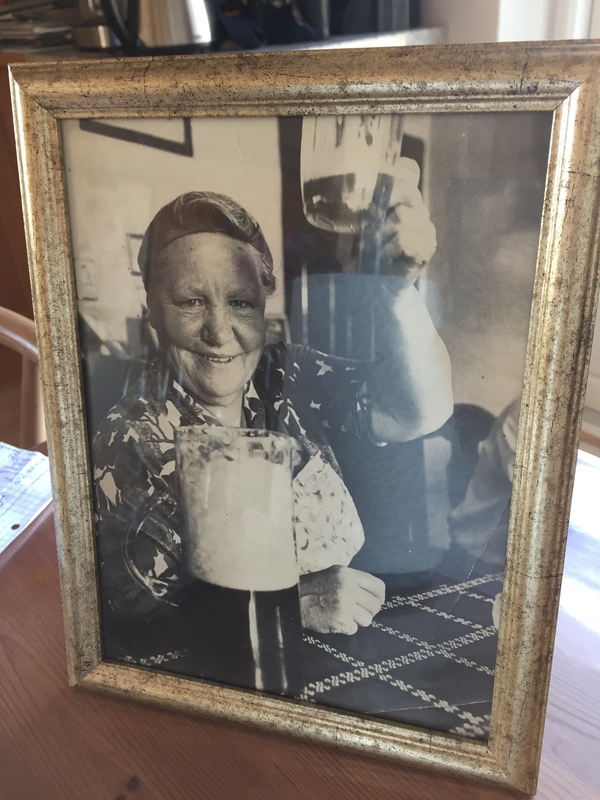
The famous and infamous Olga, with her beer. |
"Did they drive when they left," I asked, thinking about how the farm is way out in the middle of nowhere.
"Yes, everyone drove," confirmed Lotte gravely.
This seemed to stir some memory, and she started talking about how when she was young the family would just after breakfast all go into the barn to start milking and doing other work. Every day, the mailman would arrive at 0930. He went into the main house and put the coffee on. Once it was ready he came out in the barn to inform the family that the coffee was ready. Then everyone gathered round the kitchen table, with the family drinking coffee, and the mailman drinking coffee and beer. An 8% beer. Then he'd drive on, delivering the mail.
Of course, the roads around here are all low speed and fairly straight, but the easy, relaxed relationship Danes have with beer as almost an item of everyday diet is striking to a Norwegian. And that reminded me.

Nøddebjerggård seen from the road |
"In the old days, what did people use as the everyday drink," I asked.
"Beer," said Lotte. "The milk was needed for porridge and other things. And the water we got from the handpump in the yard." The handpump, she said, was right next to "møddingen," where animal manure, mouldy hay, and kitchen leftovers were dumped. She didn't say it, but clearly implied the water was not very clean. Having the trash heap next to the water pump was common, she said.
I then started on my usual questions about how the beer is brewed. Lotte said they wanted to start brewing the beer commercially, so they wouldn't give me the recipe. "That recipe in the newspaper", she said, laughing, "is just nonsense. Olga used to laugh at the journalists when they drove off, because the recipes she gave them were unusable. 30 kilos of malt and 24 liters of water? Pitch the yeast at 26C with lager yeast?" She laughed again.
She added that it was the journalist who called the beer "landøl". Maybe other people on Møn called their beer "landøl", but she didn't know about any who did.
"So what did you call the beer, then," I asked.
"Olga's beer," said Lotte with a shrug.
I had been hoping to pin down the name for the Danish farmhouse ale style, but I'd forgotten that farmhouse brewers have no use for style names.
Anyway, the brewing process she was happy to share.
The brewing started the day before, by putting the hops into water, and heating it until it reached boiling point. Then the heat was turned off, and the whole thing left to soak until the next day. The next day they started at 4 in the morning with cleaning the vessels. Then boiling water was poured on the malts, but not too much, so the malts were still pretty dry.
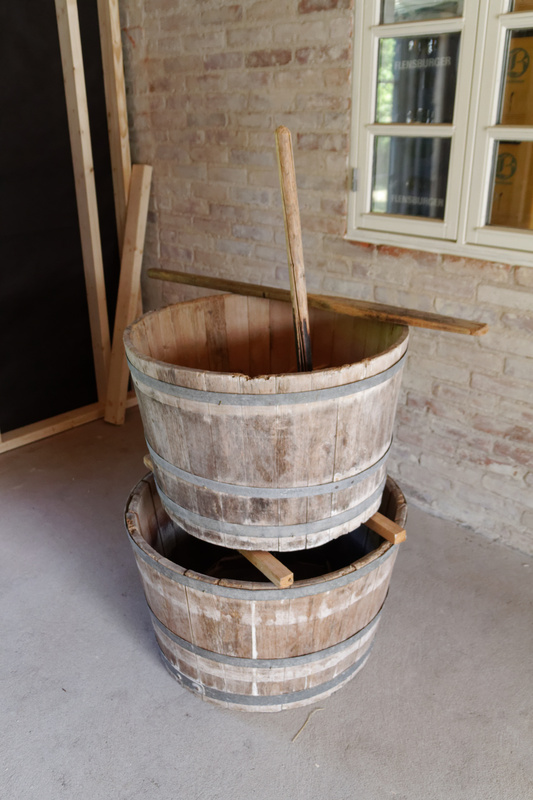
The lauter tun on top of the fermentor. |
While mashing the lauter tun was made ready with rye straw tied in fan shapes in the bottom. The lauter tun is the classic Danish and Baltic type with the long rod going through a hole in the bottom. Then the hop tea was poured through the lauter tun, filtering out the hop cones.
Then the mash was moved into the lauter tun, and more hot water added. It was left for an hour before they started lautering, slowly, to make sure none of the malts came with the wort. Then the wort was cooled to 26C (today 22-28C), and the yeast pitched. After 3-4 days of fermentation they move the beer to secondary, where they leave it 3-4 months. Olga, of course, didn't leave it that long. She brewed once a month.
So it's a classic raw ale, and the process is remarkably similar to what's described in the two archive documents I have from within 2-3 kilometers of the farm. Those also describe raw ales with hop tea filtered through the strainer.
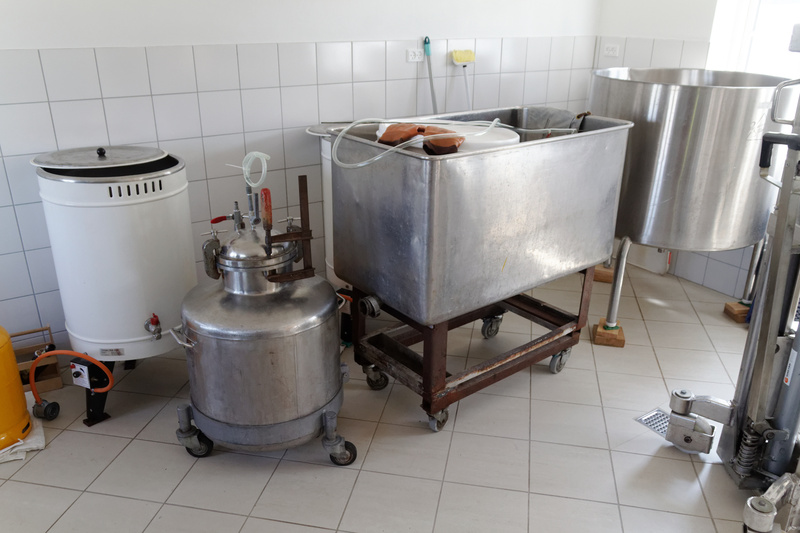
The modern brewkit. |
We headed over to the brewhouse, which they had modernized quite substantially. They still had Olga's old wooden vessels, but Lotte didn't use them because the beer went bad no matter what she did. "You can clean them dozens of times," she said, "but still..." She shrugged. They also tend to grow mouldy. "They have to dry," said Lotte, "but they can't dry out" because then they turn leaky. She shrugged again. Wooden vessels are difficult.
That's why they switched to modern steel equipment, which was earlier used for cheese production. Since they were thinking of selling the beer they have gotten a professional brewer at one of the big Danish lager breweries to advise them. They gave him some beer to serve at a tasting for the employees at the brewery, and his feedback was clear: "First of all, I want to say that one cannot brew beer the way you do it. But having said that, the beer is very good."
Lotte said Olga's last brew was in 1984, when she moved to a care home. The beer was actually served at a kind of celebration for her moving in at the care home. She died in 1988. Lotte took up the brewing again in 2005. She had brewed with Olga, so she knew what to do, but to be absolutely sure she had an older local woman with her "as a consultant." That old woman had brewed until 2000, so she was probably the last person to brew on Møn before Lotte took up the brewing again.
I asked if anyone else is still brewing on Møn, and Lotte said she doesn't know of anyone. She also thinks Nøddebjerggård is so well known for brewing that if anyone still brewed they'd get in touch with her, or someone would tell her. So apparently Møn is now down to one single brewer.
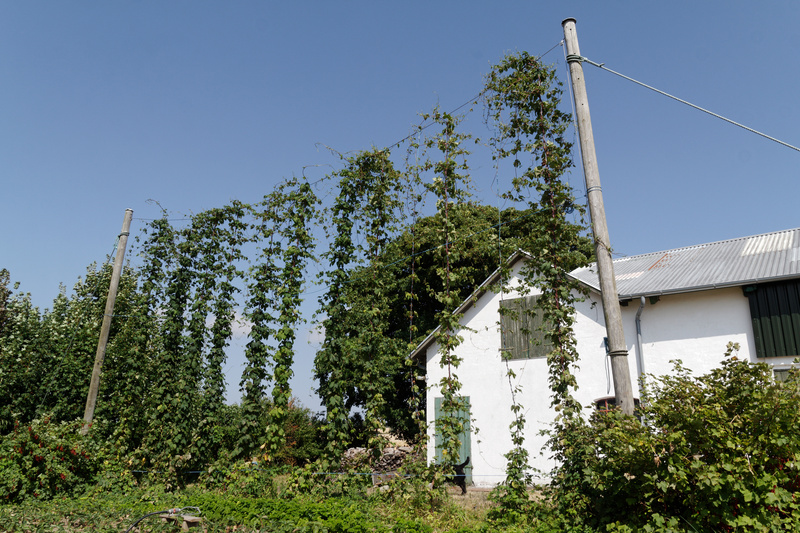
The hop garden. |
From the brewhouse we went out in the garden, because Lotte wanted to show me her hops. Olga used to buy hops in a local shop, but when Lotte went there in 2005 the shopkeeper said he hadn't sold hops since the 1980s. For a few years they got hops from the pharmacy, but now they have their own. They have three types: one is the original Nøddebjerggård hop plants, another from north Zealand, and a third from east Jutland. They grow in different lots to keep them apart.
Each autumn they let the hops down, cut the stems loose, and move everything into the house using a wheelbarrow. Then the neighbours come round and help them pick the hops while they chat and tell stories. Afterwards there's a herring dinner with beer. This sounds exactly like what the hop farmers on Funen described from a century ago in the old archive documents.
We went back to the kitchen to try the beer. Lotte opened a bottle and poured me a glass of a beer she calls "classic". I assume this is the one closest to Olga's original beer. It was 8.4%, and had matured for some months. It was pale and slightly hazy with a big, lasting head of foam. Clear fruity aroma with notes of earth and cellars. The taste was sweet and again with that fruit character, which Lotte said is from the hops, and massive malt character: nutty and caramelly with notes reminiscent of marzipan. The earthy character came back at the end and lingered a long time.
It didn't really have much raw ale flavour, and I'm not sure why. The beer warmed my mouth, and the heat lingered a good while, so Lotte was clearly not joking about the strength. Carbonation was weak, as it should be in a farmhouse ale. It was definitely a clean and well-brewed beer.
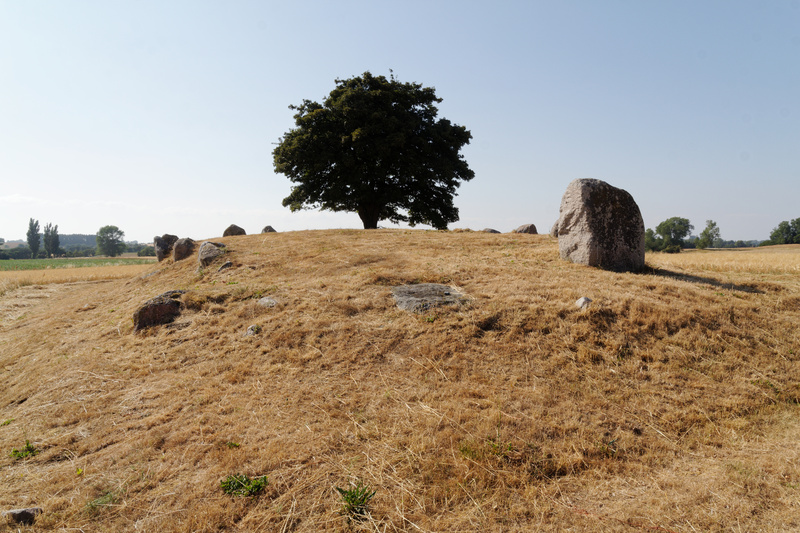
Busemarke langdysse (long barrow). |
Lotte had one more thing she wanted to show me. We went out of house, out of the yard, and along a ditch between the fields. Then we cut across the ripe barley to a small mound in the middle of the field, with a tree on it. It's a long barrow, a grave, built by the Funnelbeaker culture around 3500 BCE. These graves were built to be used for multiple burials, and one of the stones has bowl marks cut into it. The marks were added in the Bronze Age, more than 2000 years after the barrow was built.
Lotte said that one of Olga's rules was that you couldn't brew during a thunderstorm, because then the beer would turn bad. Of course, the storm could start while you were already brewing, and if that happened Olga would take a bottle of beer up on the barrow and say some words over the beer. Lotte said she'd done this together with Olga, but she couldn't remember the words. She was not sure whether Olga really believed in it, or whether she just did it for fun.
The Funnelbeaker culture were the people who brought grain growing to Denmark, and personally I think it's likely that they also brought the knowledge of brewing. So most likely the farmers on Møn have been brewing farmhouse ale continuously for more than 5500 years. That ancient tradition stopped in 2000, but didn't die, since Lotte decided to start it up again. Thanks to her, and her alone, the tradition still lives on Møn, and the traditional Danish raw ale is still being brewed.
Living on a farm where people can drop by for a chat and a beer is important to her, Lotte said. She wants her kids to experience living on a farm where people stop by like that. Keeping up the tradition of serving beer that Olga started was part of why she started brewing again.
It's been two years since that visit, so I reached out to Lotte by email to hear what's happened since, and she says they are now selling the beer commercially on the farm. So I'm happy to tell you that now you can actually drive out to Nøddebjergaard on Møn and buy yourself some real Danish farmhouse ale through August, if covid-19 restrictions allow.
Lotte served me two beers, one of which did not seem to be the traditional beer, so you may want to check which one is the original.

The burial chamber of the barrow, with Nøddebjerggård in the background. |
Similar posts
Berm: Yeast from Upper Telemark
I was doing a talk about kveik in Oslo, when one of the audience members afterwards said that in his home village people also had their own yeast, but they called it "berm"
Read | 2024-04-03 21:09
Brewing in Chuvashia
Suddenly, the bus drove out of the forest, onto a bridge spanning an enormous river, deep blue in the sunshine, and so wide it looked more like a lake
Read | 2019-02-03 11:26
Comments
John Horn - 2020-08-09 16:11:29
A lovely post! My family immigrated from the East Jutland area to Nebraska many years ago. Obviously, not the area that this post is about but still it's interesting to read about farmhouse brewing in Denmark. I'd love to try a hand at brewing some traditional raw ale like this.
Keri Byrum - 2020-08-09 18:42:57
I love reading the story behind this beer and would love to meet Olga someday-- and support her commercial brewing too!
Mark - 2020-08-09 19:17:01
So, was it actually a lager yeast? Or did they have their own Landrace yeast?
Very intrigued by the 22-28c pitch. I ferment W34/70 up to 23c without issue, but 28c seems a bit much.
Gregory Horwitz - 2020-08-09 20:23:54
What a grand story, beautifully written as usual. Bless her for keeping this tradition alive for her kids to experience and remember.
Joe - 2020-08-10 01:10:06
Lovely story and journey. Would love to try some of Olga’s original. I hope Lotte keeps the tradition alive and generates more interest in the other family farms on the island. Keep it going for another 7000 years to come! Loved the bit at the end of the ancient farmers and their burial grounds on the far... really ties the whole thing together nicely. Ps: I’ve only brewed during a thunderstorm once and the beer was absolutely terrible... :) wish she remembered the words!
Lars Marius Garshol - 2020-08-10 13:46:49
@Mark: They didn't say what yeast they used, but it was not farmhouse yeast. I asked specifically about that. I don't think they're using lager yeast, but I think Olga told the journalists to put that in the recipes in the newspapers.
@Joe: I think you also need the burial mound for it to work. :)
Chino - 2020-08-15 20:12:25
Very cool, Lars. Did you ever find out where the malt came from? Did they malt barley from the farm, get it from a neighbor, buy it from a commercial malting house, that sort of thing?
Norberto Pazos - 2020-08-15 21:37:20
@Lars: great story! thanks so much for sharing it and for taking the time for this journey. It is a pity that you didn't get the recipe though.
@Keri: I think if you met Olga now you would be very much scared!
Lars Marius Garshol - 2020-08-16 10:19:03
@Chino: They used ordinary commercial malts. Historically, people on Møn did make their own malt, drying it in a wooden frame with a perforated bottom that the smoke passed through. So historically they had powerfully smoked malt. But that's probably 100 years ago now.
Jesper Hjortshøj Nørr Petersen - 2020-12-17 06:30:07
Hi I stumbled upon this video. You have probably seen it already, but in case you haven't, I guess it could be interesting. https://youtu.be/g2sA8ZoawWE
Lars Marius Garshol - 2020-12-17 08:03:02
@Jesper: I have seen it, but thank you, anyway. Always welcome to get tips, because sometimes it is things I haven't found.
Nick Charles - 2023-06-02 17:24:47
Hello Lars, I just stumbled onto a book,”Sacred and Herbal Healing” by Stephen Harris Buhner and immediately wondered if you’ve read it too? I’d describe it as a treasure trove and lively companion for any farmhouse ale brewer. Chapter Eight,”Beers and Ales from Sacred and Medicinal Trees” has a long section on juniper with recipes. A corn beer, Chiacoar, is described as made from baked corn bread like keptinis, but different. Yeast is covered. The main take away so far is there is much to be learned from the astounding world of plants. Enjoy this book if you haven’t already. Prepare for a deep dive followed by inspiration, experimentation and joy!
Lars Marius - 2023-06-06 14:50:48
@Nick: Yes, I've read "Sacred and Herbal Healing Beers" and I'm a bit torn about it. Some of it is very good research (particularly for the time), and some of it is very unreliable New Age stuff. Glad to hear you enjoyed it.